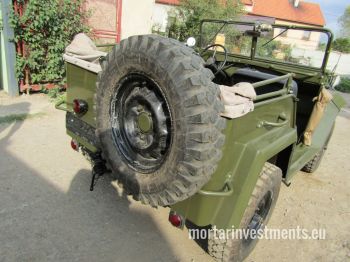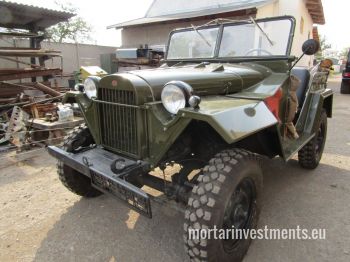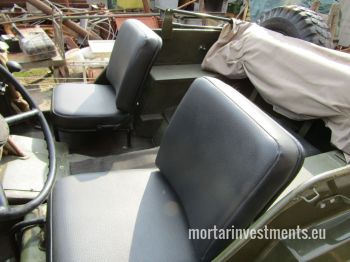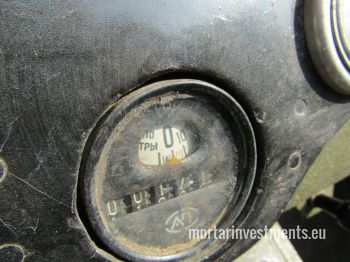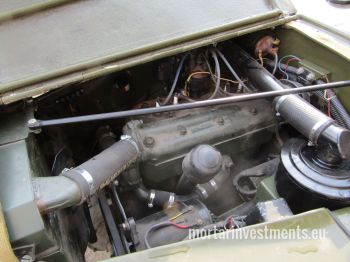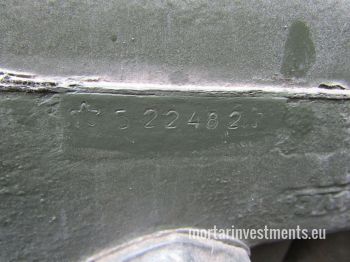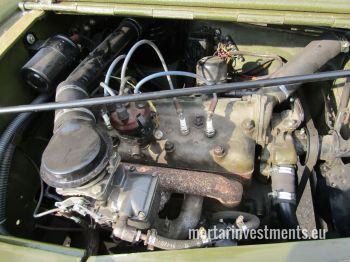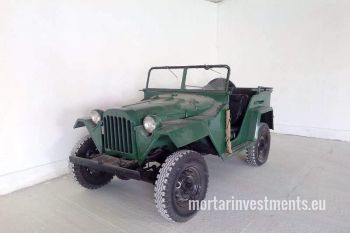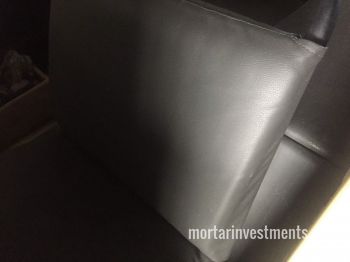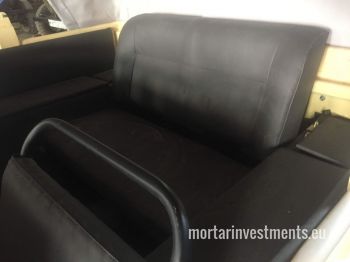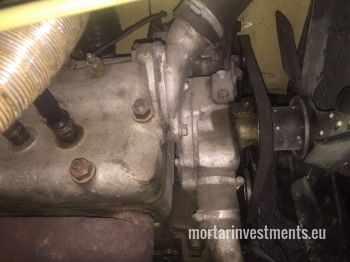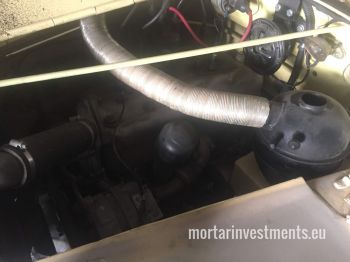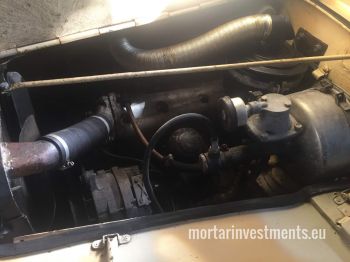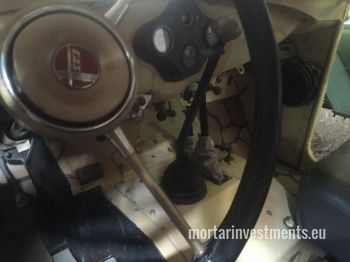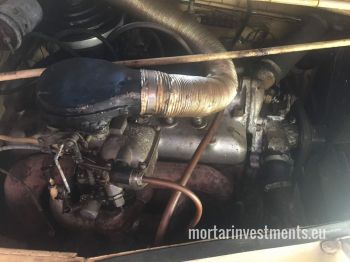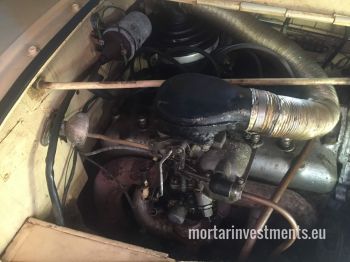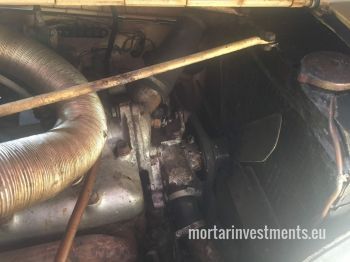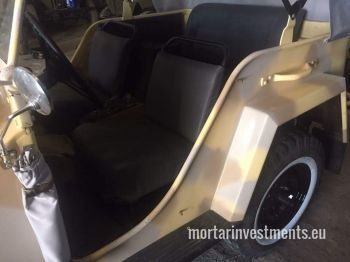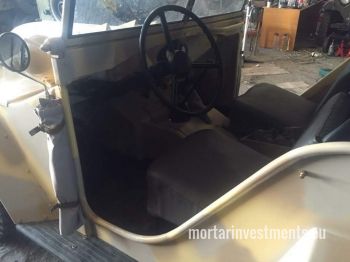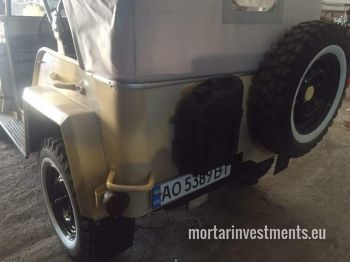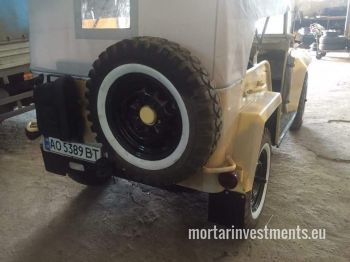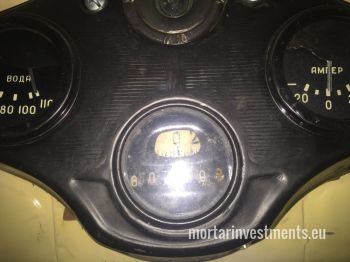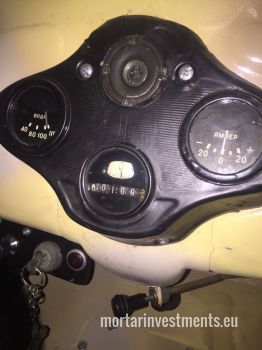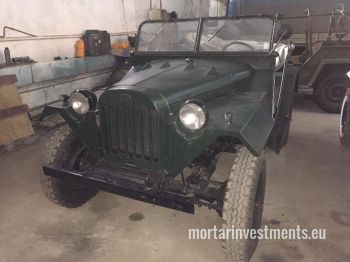
GAZ 67
Price on demand
General
| Produced | 1943-1953 |
| Notable for | Russian Willy's |
Engine
| Type | 4-cyl GAZ-MM |
| Fuel | gasoline |
| Power | 54 hp |
| Maximum Torque | |
| Displacement |
Variants
Dimensions
| Curb Weight | |
| Wheelbase | |
| Crew | 5 |
| Height | 1,700 m |
| Length | 3,345 m |
| Width | 1,685 m |
| Ground Clearance |
Policy
| Driving Licence | Car |
| Can be transported in a container? | |
| Requires an Export Licence? |
Driving capacities
| Fuel Capacity | |
| Fuel Consumption | 3,28 L/100 km |
| Speed on Road | 90 km/h |
| Speed Cross-country | |
| Payload |
Transmission
| Type |
Other
| Voltage | |
| Tyre Size |
Description
Top-of-the-line Soviet WWII jeep GAZ-67 and GAZ-67B for sale. Buy a superb Russian 4x4.
GAZ-67 and GAZ-67B - vintage Soviet military all-wheel-drive cars with a simplified open body, which had cutouts instead of doors. They represented a further modernization of the GAZ-64 model. Like her, they were created under the leadership of the lead designer V. A. Grachev on the basis of GAZ-M1 units. At the final stage of World War II and later the Korean War, the GAZ-67B was widely used as a headquarters and reconnaissance vehicle, a carrier of infantry and wounded, as well as a light artillery tractor.
The production volumes of the GAZ-67 and GAZ-67B during the war years were relatively small - 4851 units, which amounted to less than 1/10 of the supply to the USSR Lend-Lease Willys MB and Ford GPW, since the main attention was paid to the production of the BA-64B armoured car, with which SUVs were unified by chassis. The volume of production of the GAZ-67 amounted to 3137 units, the GAZ-67B until the end of the war 1714 units were produced, and in total until the end of production in 1953 - 92 843 units.
After the war, the GAZ-67B was actively used not only in the army, but also in the Ministry of State Security, the Ministry of Internal Affairs, exploration, forestry and agriculture, etc. The BKGM-AN hydraulic crane-crane machine was produced on its basis (the first case in the world of drilling -crane machine in a passenger car), as well as snowploughs.
We also sell GAZ-AA and GAZ-69 vehicles.
Construction features
To improve the aerodynamics of the engine compartment, at the suggestion of the designer B. T. Komarevsky, exhaust slots were made in the rear part of the hood covers - “vents” (contrary to the conventional wisdom - not for heating the windshield). Shortened compared with the GAZ-61 (by 755 mm) the base of the car allowed to abandon the rear intermediate propeller shaft. The front open propeller shaft received bearings on the GAZ-51 Cleveland type needle bearings. In order to increase the front angle of entry to 75 degrees and to facilitate overcoming vertical walls (up to 0.5 m), on the proposal of V. A. Grachev, the front axle was suspended on 4 quarter-elliptic springs. Such a suspension is characterized by insufficient reliability - frequent breakdowns of sheets due to their irrational and sharp loading, as well as low lateral rigidity. For the stability of the rectilinear movement (the absence of “walking” the car), well-protected and durable threaded fingers and bushings from the GAZ-11 were used in the joints of all springs.
In order to avoid resonant galloping with such a short base and the chosen suspension, powerful hydraulic shock absorbers were needed. The designers were forced to put four shock absorbers (two per axle) single-acting from the GAZ-M1, obviously unreliable and ineffective. More energy-consuming and efficient double-acting shock absorbers GAZ-11 type "Delco" were still in the development stage. The all-terrain vehicle received GAZ-11 shock absorbers only in the third quarter of 1951.
The steering drive differed from the GAZ-61 in that the transverse steering rod passed in front of the front axle beam and was straight, without bending, which sharply increased its rigidity (insufficient on the GAZ-61), although it made it more vulnerable to frontal impacts. According to the layout and design of the frame, the steering column was unusually tilted to a large angle (10.27 degrees) in plan, but this did not make it difficult to control.
The mechanical drive of the brakes of all wheels is the same cable one as on the GAZ-11-73, but with a rigid transfer shaft-driven equally by a foot pedal and a manual lever. For simplicity of construction, equalizers were not used.
Tires with "split Christmas tree" type grousers of 6.50-16 domestic production size (YaShZ), designed for GAZ-64, significantly increased passability on deformable surfaces, in particular, moist soils, loose snow. Having an elastic treadmill, these tires, in comparison with those used on the GAZ-61 (with the tread pattern "Ground-flu"), reduced rolling resistance on a hard surface and were more durable. They were then put on all GAZ all-terrain vehicles in 1958. However, due to the lack of 6.50-16 tyres, tyres 7.00-16 from GAZ-M1 with a highway tread pattern were quite often used, almost no different in diameter and width from the all-terrain 6.50-16, but with a limited patency. All electrical equipment and devices were used in existing production - from GAZ-M1 and GAZ-MM. Their number has been reduced to the limit. In particular, there was no oil pressure gauge, coolant temperature gauge. The GAZ-67 retained the basic power and kinematic concept of the chassis, which paid off well on the GAZ-61: the use of a relatively slow engine with increased torque and an elastic external characteristic in combination with a 4-speed gearbox with a large power range that did not require the installation of a 2-speed de-multiplier (as in "Bantam") and more convenient to manage. Leading designer V. A. Grachev made a bet on achieving an unprecedentedly high dynamic factor (the ratio of free traction on wheels to gross weight) 0.74 - as on the GAZ-61, which theoretically made it possible to overcome the rise on hard ground to 45 degrees, and also on the use of low-pressure tires with grousers.
The body created by B.T. Komarevsky is an open, universal purpose, with three seats for four people (front - separate, rear - general 2-seater). Two more could sit on the shelves of the hind wings. It also housed small arms, ammunition (up to 45 mm shells) and special equipment (walkie-talkie). For an unhindered and quick exit, the body was doorless - the front apertures in bad weather were covered with tarpaulin aprons. A tarpaulin awning of the simplest form without sidewalls adhered to one arc (then two). The windshield (according to the experience of the war, the windshield was installed strictly vertically so as not to reflect solar glare upwards) in a rigid tubular frame was tilted forward and fixed in a horizontal position. Only the driver had a wiper with a vacuum drive. All body surfaces had a flat shape or bent in the same plane to form a box-shaped structure, which made it easy to manufacture. The ends of steel body panels (1.0-1.9 mm thick) were edged with pipes. All joints were connected by spot welding, occasionally arc. In the design of the front end of the car, GAZ-AA elements were used: the upper part of the radiator casing
GAZ-67 differed from GAZ-64 in a wider gauge - 1445 mm instead of 1250 mm (due to deviations in production it reached 1460 mm), received a reinforced frame, the spars of which had a completely closed profile, as well as kerchiefs, linings, an additional rear cross member. The front bumper is moved forward by 40 mm (thereby eliminating one of the shortcomings of the GAZ-64: the rapid appearance of cracks in some overstressed frame elements during front-line operation), wing expanders appeared (the width of the body along the sides almost did not change - 1442 mm), a new dashboard, the footboards are installed flush with the wings, a more powerful (54 hp at 2800 rpm instead of 50 hp) motor, the maximum torque of which increased to 18 kgf · m at 1400 rpm, an additional gas tank of 33 litres. and a number of other changes. Engine power increased mainly due to the use of more advanced K-23 Stromberg carburettors (subsequently K-23B) without a pneumatic economizer and with the refinement of their adjustments.
The rear springs are located above the bridge casings (this increased the ground clearance under them) and rested on the frame through the outer cantilever brackets. Due to the increase in spring gauge, the rear anti-roll bar became unnecessary. Due to low efficiency and chronic shortage, they removed the second pair of shock absorbers from the rear suspension. On the GAZ-67, the front suspension elements were reinforced (cast springs of malleable cast iron eyelets of springs instead of non-rigid stamped ones, which also managed to be welded), the mounting of the crankcase and steering bracket, the steering wheel, the mounting of the spare wheel to the rear wall of the body, and the towing device. An additional gas tank (33 l.) Is located under the driver's seat. He connected to the power system through a three-way valve from GAZ-AAA. The battery has been moved to a dedicated compartment behind the front right wing. Access to it has become more convenient, but the length of the power cable to the starter (it is located to the left of the engine) has increased and thereby electrical losses have increased slightly.
The air filter (from GAZ-M1, but with the grid from GAZ-11) is more conveniently located to the left of the engine and connected it to the carburettor with a long pipe. The upgraded engine retained the old designation GAZ-64-6004 (sometimes 64-6004-B). The dimensions of the GAZ-67 increased slightly in length (up to 3345 mm) and noticeably in width (up to 1720 mm, then limited to 1685-1690 mm). The front overhang was 470 mm, the rear 775 mm. The height with the tent up and the windshield lowered, as well as the clearance under the rear axle (227 mm), have not changed. When installing tires 7.00-16 (and this practice periodically continued, even after the war), the clearance increased to 235 mm. The steering wheel height (with the windshield lowered) was 1270 mm, the hood was 1160 mm, the spare tire was 1307 mm. Thus, the GAZ-67 was characterized by a rather low silhouette (according to the American requirements for "jeeps" - 50 inches, that is 1270 mm), which facilitated movement in the thickets and camouflage. The given drawing dimensions were not always maintained in production. The curb weight increased to 1376 kg (full, with four passengers, up to 1672 kg). In the process of developing products, the curb weight decreased to 1342 kg and subsequently stabilized in the official 1320 kg region. The angles of entry and exit remained large: 68 degrees (slightly decreased due to the removal of the front bumper) and 44 degrees, respectively. Profile cross-country parameters as a whole did not change and were still high: lifting to 38 degrees, with a trailer of 800 kg to 20 degrees, lateral stability limit - 28 degrees, actually even more (up to 45 degrees). The turning radius increased, but not by much - up to 5.85 m. The affordability - without preparation 0.55 m, with special training - 0.8 m. Compared to its predecessor, mobility on broken roads with deep (up to 0.45 m) significantly improved ) with ruts laid by heavy trucks - the car fit well in them and could confidently go to the side of the road through ditches with steep walls, move along slopes with a slope of up to 22 degrees without slipping. Despite the wide track, the radius of the transverse cross was quite small - 1.36 m.
A lane with liquid mud 0.8 m deep (to the top of the wheels) was overcome without difficulty in the 2nd - 3rd gears (source not specified 1024 days). Ground pressure with full load: front wheels - 2.65 kgf / cm2, rear - 3.9 kgf / cm2. The depth of the heaviest snow to be overcome - firn - reached 0.4 m. With snow chains of 0.15 m deep, a climb of 23 degrees was taken. The maximum speed on the highway, compared with the GAZ-64, decreased slightly: up to 88 km / h (due to an increase in gross weight and an increase in the frontal area of the body by 29%), minimum fuel consumption (gasoline of the second grade with an octane rating of 55- 60, later allowed 66-70) on the highway per 100 km in the summer was 13.2 litres, in winter 13.7 litres, which
It would give a range of 520-535 km. In actual operation, it was lower - on the highway on average 405 km, on a dry country road 335 km.
Excellent traction properties of the engine allowed the GAZ-67 to travel uphill to 6 degrees (10.5%, on the highway it is rarely higher) when driving on a highway without losing speed (with a trailer - 3 degrees). On snowy asphalt, the maximum traction force on the GAZ-67 hook at a load of 300 kg was 1050 kgf at a speed of 4 km / h, on a dry concrete road up to 1220 kgf. And although compared with the GAZ-64, the maximum dynamic factor dropped to 0.71 (the gross vehicle weight increased), it still remained very high for a passenger all-terrain vehicle (at Willis it did not exceed the value of 0.61). The mass of the trailer in any road conditions, as shown by sea trials, could reach 1250 kg (57-mm anti-tank gun ZiS-2). Then in operation, it was limited to 800 kg. With a relatively heavy 76-mm gun, the GAZ-67 worked with overload, with loss of dynamics, but even then the maximum speed on the highway reached 58.5 km / h, and ascent on rolled snow up to 7 degrees. Such movement was not recommended, but allowed in special cases over short distances. He gained speed from 15 to 75 km / h in direct transmission in 27 s, moving with an average acceleration of 0.62 m / s2. The maximum acceleration - 2 m / s2, was achieved during acceleration in 2nd gear. A special visiting card of the GAZ-67 was a 4-spoke steering wheel with a curved wooden rim with a diameter of 385 mm, forcedly mastered by production in one day due to the failure of the factory supplying carbolite parts (it burned down during the bombing). Despite the unpretentious and even archaic look, such a steering wheel took root, the drivers even loved it for the convenience of working without gloves, especially in cold weather, and were in no hurry to replace it with a plastic one on occasion. And the new 3-spoke plastic steering wheel with a diameter of 425 mm, specially created for the GAZ-67B, turned out to be so successful and satisfying every one that it became standard for post-war GAZ trucks and is still available. The manufacture of rear axle shafts made of steel 35KhGSA practically eliminated their breakdowns, although it did not prevent it at all with large overloads.
GAZ-67B
Modernized in 1944, the GAZ-67B received a front axle and transmission reinforced for a number of nodes. Ball angular contact kingpin bearings of the axle pivots of the front axle, inherited from the GAZ-61, had an extremely low resource (5 ... 8 thousand km). In November 1944, they were replaced by bearings of the White type, which were more durable, repairable and not afraid of shock loads. In addition, they were not so sensitive to contamination due to the unreliability of compaction of the spheres of ball bearings. There were no more complaints about this unit in operation. A similar technical solution for the pivot bearings turned out to be successful and was subsequently used for a long time on other light all-terrain vehicles of the plant: GAZ-69, GAZ-62, GAZ-M72, GAZ-M73. From November 15, reinforced mounting of the front wheel hub bearings was introduced, the front axle shaft splined seal was improved, and the front springs were fastened with reinforced through bolts instead of step ladders (from October 25). The flat rubber pillows of the struts of the shock absorbers have been replaced by swivel joints, more durable, more rigid wheels of the wheels of a simplified configuration with a metal thickness increased by 0.5 mm (up to 3.6 mm) have been introduced. To reduce the “wobble” of the wheels, especially when their unregulated bearings are worn, from November 5, 1944, the angle of inclination of the axis of the kingpin forward (castor) was reduced to 2 degrees. Finally, from October 23, instead of the Emov’s IM-91, the engine was supplied with a more advanced R-15 type distributor, which was maximally unified with the R-12 distributor of the GAZ-11 6-cylinder engine. Connected to spark plugs with insulated high-voltage wires (instead of copper plates), it ensured the maintenance of its stable adjustment and better dust and moisture protection of electrical connections with the possibility of shielding them from the generated interference.
Under the leadership of the lead designer G.M. Wasserman (V. A. Grachev was appointed chief designer for the Dnepropetrovsk automobile plant under construction, the future Yuzhmash), in 1948 the welded radiator grille was replaced with a stamped one with seven vertical slots, a number of units were introduced, unified with GAZ-M20 and GAZ-51: K-22 type carburettor (not on all cars), fuel sump filter, once again the new R-30 ignition distributor with octane corrector, improved main axle gears, as well as double shock absorber action (since 1951). GAZ-67B was produced until the end of August 1953, and in 1953 the largest number of cars was manufactured - 14502. Their production reached 70 units per day. In total, over 10 years, according to updated data - 92843.
Technical specifications
- Drive formula: 4 × 4
- Engine: 4-cylinder gasoline engine, almost identical to that of the GAZ-MM truck
- Displacement: 3280 cm³
- Power: 54 hp (40 kW)
- Chassis: rigid axles, front on four-quarter elliptical cantilever leaf springs, rear on two semi-elliptical leaf springs, all springs installed lengthways
- Top speed: 90 km / h (road)
- Consumption: 13.2 l
- Production period: 1943-1953
- Number of units built: 92,843
Dimensions and weights
- Length: 3,345 m
- Width: 1,685 m
- Height: 1,700 m
- Track width: 1446 mm
- Wheelbase: 2100 mm
- Ground clearance: 227 mm
- Radius: 11.6 m
- Weight: 1320 kg
- Payload: 4–5 people or 400 kg
